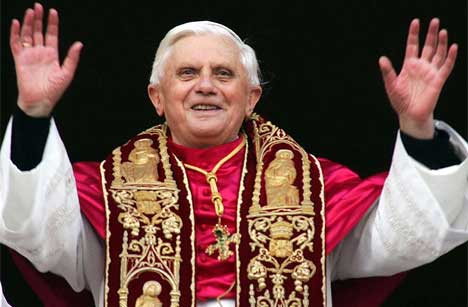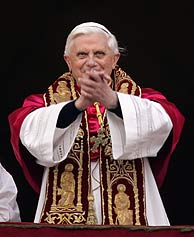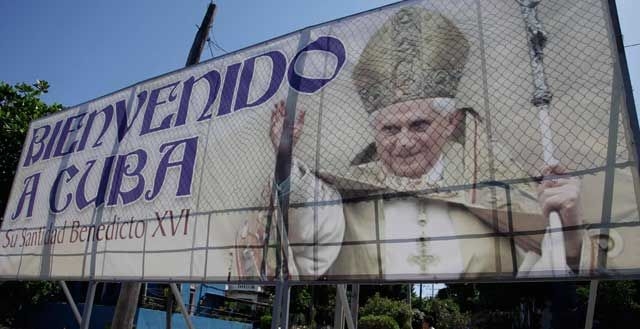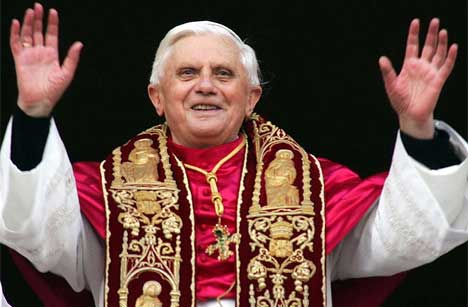The Holy Father participated in the traditional in-flight press conference with the more than seventy journalists accompanying him on the plane. He answered questions on a wide range of subjects, from drug trafficking and violence in Mexico to the social situation in Cuba and new evangelisation on the Latin American continent.
His Journey…
The Pope noted that his journey was taking him in the footsteps of John Paul II, who had made five visits to Mexico and one to Cuba, and that he hoped to continue the work begun by his predecessor. “I share the joys and hopes, but also the suffering and difficulties” of the Mexican people, he said. “I am going to bring encouragement but also to learn, to bring comfort in faith, hope and love; a commitment to goodness and to the struggle against evil. Let us hope that the Lord will help us”.
….”The Church must of course ask if she does enough for social justice on that great continent”, the Pope replied. “It is a question of conscience which we must always pose ourselves. … What must the Church do? What can she not do? What must she not do? The Church is not a political power, she is not a party but a moral entity, a moral power. … I reiterate what I have already said. The Church’s first concern is to educate minds in both individual and public ethics, thus creating the necessary sense of responsibility. Here perhaps there are some shortcomings. In Latin America, as elsewhere, no small number of Catholics show a kind of schizophrenia between individual and public morals. … We must educate people to overcome this schizophrenia, educate them not only in … individual morality, but also in public morality. This we must seek to do with the social doctrine of the Church because, of course, such public morality must be a reasonable morality, shared and shareable by non believers. We, of course, in the light of faith can better see many things that are also visible to reason, but it is faith which serves to liberate reason from the false interests that cloud it. Thus we must use social doctrine to create fundamental policy models, and so … overcome these divisions”.
Another journalist recalled the words used by John Paul II on his trip to Cuba, “may Cuba open to the world and, and may the world open to Cuba”, and noted that many defenders of human rights had spoken out in anticipation of Benedict XVI’s visit to the island.
….The Pope reiterated the continuity of his ideas with the words of John Paul II “which are still highly relevant”. The visit marked, he said, “the beginning of a journey of collaboration and constructive dialogue, a long journey which requires patience but which is moving forward. It is clear today that Marxist ideology as it was conceived no longer responds to reality. … In order to build a new society new models must be discovered, patiently and constructively. In this process, which requires patience but also firmness, we wish to make our contribution in a spirit of dialogue, in order to avoid traumas and facilitate the way to a fraternal and just society for all people. Obviously, the Church is always on the side of freedom, freedom of conscience, freedom of religion. … The faithful can also contribute to the progress of this journey”.
“Today it is evident that Marxist ideology in the way it was conceived no longer corresponds to reality,” the pope said on the flight to Mexico, where he landed on Friday afternoon. “In this way we can no longer respond and build a society. New models must be found with patience and in a constructive way,” he said, extending the Church’s offer to help with a transition in one of the world’s last communist countries.
This pope’s work will be to build on recent gains by the Church in its relations with the government and seeking a bigger role in a time of change under President Raul Castro. A senior Vatican official, who requested anonymity, said recently the pope wanted to assure the Cuban government that its former enemy only wanted to be helpful, not threatening, as Raul Castro undertakes reforms to improve Cuba’s Soviet-style economy.
“The pope wants to help Catholic leaders convince the government that it has nothing to fear from the Church in Cuba,” the official told Reuters.
“The Church wants to help in education, in teaching moral values. That can only help all of Cuban society as it embarks on many changes in the political and social spheres.”
The Cuban rumor mill has been in full swing with speculation that as a gesture to the 84-year-old pope, the Cuban president might release more political prisoners, free jailed American contractor Alan Gross or finally unveil immigration reforms he promised last year.
Cuba’s Reality
Dissidents in Havana, Holguín, Guantanamo, Matanzas, Palma Soriano, Pinar del Río, Sancti Spíritus, and Santiago de Cuba described to Human Rights Watch the repressive tactics currently being used by the Cuban government. They said that when they sought to exercise their basic rights to speak up about human rights concerns and hold rallies over the past few weeks, the authorities responded with beatings, detentions, harassment, and other repressive measures. Pope Benedict XVI is scheduled to be in Cuba from March 26 to March 28, 2012, to visit Havana and Santiago de Cuba.
“The arrests, beatings, and threats against dissidents in the lead up to the pope’s visit suggest the Cuban government will do everything in its power to quash any dissent while the world’s attention is on the island,” said José Miguel Vivanco, Americas director at Human Rights Watch. “These repressive acts underscore just how little space there is in Cuba for any view that doesn’t align with the Castro government.”
Sources: VaticanPressOffice/InternetPhotos/TheCubanHistory.com
Pope Benedict’s Mission to Cuba/ The Cuban History/ Arnoldo Varona, Editor
EL PAPA BENEDICTO MISION A CUBA
El Santo Padre participó en la tradicional rueda de prensa en vuelo con los más de setenta periodistas que le acompañaban en el avión. Él respondió a las preguntas sobre una amplia gama de temas, desde el tráfico de drogas y la violencia en México a la situación social en Cuba y la nueva evangelización en el continente latinoamericano.
Su viaje …
El Papa señaló que su viaje le estaba tomando las huellas de Juan Pablo II, que había hecho cinco visitas a México y una en Cuba, y que esperaba para continuar la labor iniciada por su predecesor. “Comparto las alegrías y esperanzas, pero también el sufrimiento y las dificultades” del pueblo mexicano, dijo. “Voy a dar ánimo, pero también para aprender, para llevar consuelo en la fe, la esperanza y el amor;. Un compromiso con la bondad y la lucha contra el mal Esperemos que el Señor nos ayudará”.
…. “La Iglesia debe, por supuesto, preguntar si ella hace lo suficiente por la justicia social en ese gran continente”, el Papa respondió. “Es una cuestión de conciencia, que siempre debemos plantearnos …. ¿Qué debe hacer la Iglesia? ¿Qué no puede hacer ella? ¿Qué no debe hacer ella? La Iglesia no es un poder político, no es un partido sino una entidad moral, un poder moral …. Repito lo que ya he dicho. primera preocupación de la Iglesia es educar a la mente en la ética individual y pública, creando así el necesario sentido de responsabilidad. Aquí tal vez hay algunas deficiencias. En América América, como en otros lugares, no pocos de los católicos muestran una especie de esquizofrenia entre la moral individual y pública …. Tenemos que educar a la gente para superar esta esquizofrenia, educarlos, no sólo en … la moralidad individual, sino también en la moral pública. Esto es lo que debe buscar que ver con la doctrina social de la Iglesia porque, por supuesto, a la moral pública, debe ser una moral razonable, compartido y compartible por los no creyentes. Nosotros, por supuesto, a la luz de la fe pueda ver mejor muchas cosas que También son visibles a la razón, pero es la fe, que sirve para liberar la razón de los intereses falsos que nublan. Por lo tanto debemos usar la doctrina social de la creación de los modelos fundamentales de la política, y así … superar estas divisiones “.
Otro periodista recordó las palabras utilizadas por Juan Pablo II en su viaje a Cuba, “Que Cuba se abra al mundo y, y que el mundo se abra a Cuba”, y señaló que muchos defensores de los derechos humanos se había pronunciado a la espera de Benedicto XVI visita a la isla.
…. El Papa reiteró la continuidad de sus ideas con las palabras de Juan Pablo II “, que siguen siendo de gran relevancia”. La visita marcó, dijo, “el comienzo de un viaje de la colaboración y el diálogo constructivo, un viaje largo que requiere paciencia, pero que está avanzando. Hoy es claro que la ideología marxista, tal como fue concebido ya no responde a la realidad … . Con el fin de construir una nueva sociedad nuevos modelos deben ser descubiertos, con paciencia y de manera constructiva. En este proceso, que requiere paciencia, pero también firmeza, queremos hacer nuestra contribución en un espíritu de diálogo, a fin de evitar traumas y facilitar el camino a una sociedad fraterna y justa para todas las personas. Obviamente, la Iglesia está siempre en el lado de la libertad, la libertad de conciencia, la libertad de religión …. Los fieles también pueden contribuir al progreso de este viaje “.
“Hoy en día es evidente que la ideología marxista en la forma en que fue concebido ya no corresponde a la realidad”, dijo el Papa en el vuelo a México, donde aterrizó en la tarde del viernes. “De esta manera, ya no pueden responder y construir una sociedad. Los nuevos modelos se debe encontrar con paciencia y de una manera constructiva”, dijo, ampliando la oferta de la Iglesia para ayudar a una transición en uno de los últimos países comunistas del mundo.
El trabajo de este Papa será el de construir sobre las ganancias de los últimos por la Iglesia en sus relaciones con el gobierno y la búsqueda de un papel más importante en un momento de cambio con el presidente Raúl Castro. Un alto funcionario del Vaticano, que pidió el anonimato, dijo recientemente el Papa ha querido asegurar que el gobierno cubano de que su antiguo enemigo sólo quería ser útil, no una amenaza, ya que Raúl Castro se compromete a mejorar las reformas de estilo soviético de Cuba la economía.
“El Papa quiere ayudar a los líderes católicos convencer al gobierno que no tiene nada que temer de la Iglesia en Cuba”, dijo el funcionario a Reuters.
“La Iglesia quiere ayudar en la educación, en la enseñanza de valores morales. Eso sólo puede ayudar a toda la sociedad cubana que se embarca en muchos cambios en las esferas política y social”.
El rumor de Cuba ha estado en pleno desarrollo con la especulación de que como un gesto hacia el Papa de 84 años de edad, el Presidente cubano podría liberar a más prisioneros políticos, libertad encarcelada contratista estadounidense Alan Gross, o, finalmente, revelar la reforma migratoria que prometió el año pasado.
la realidad de Cuba
Los disidentes en La Habana, Holguín, Guantánamo, Matanzas, Palma Soriano, Pinar del Río, Sancti Spíritus y Santiago de Cuba, describió a Human Rights Watch las tácticas represivas que se utilizan actualmente por el gobierno cubano. Dijeron que cuando se trataba de ejercer sus derechos básicos a hablar sobre los problemas de derechos humanos y realizar reuniones más de las últimas semanas, las autoridades respondieron con golpes, detenciones, acoso, y otras medidas represivas. El Papa Benedicto XVI está programado para estar en Cuba desde marzo 26 hasta marzo 28 2012, para visitar La Habana y Santiago de Cuba.
“Los arrestos, golpizas y amenazas contra los disidentes en el período previo a la visita del Papa sugiere que el gobierno cubano hará todo lo que esté a su alcance para aplastar cualquier disidencia, mientras que la atención del mundo está en la isla”, dijo José Miguel Vivanco, director para las Américas en el Human Rights Watch. “Estos actos represivos subrayan cuán poco espacio que hay en Cuba por cualquier punto de vista de que no se alinea con el gobierno de Castro.”
Fuentes: VaticanPressOffice / InternetPhotos / TheCubanHistory.com
Misión del Papa Benedicto XVI a Cuba / La Historia de Cuba / Arnoldo Varona, Editor







